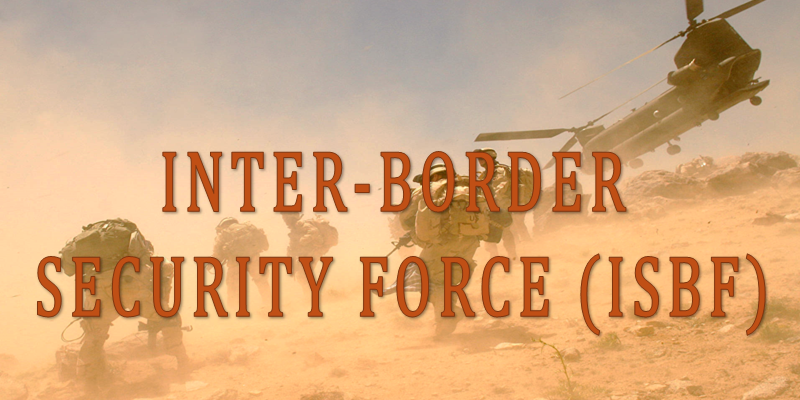
Article Keywords : Internal Security, Cooperative Federalism, Inter-Border Security Force (IBSF), Jurisdictional Vacuum, Hybrid Threats, Narco-Terrorism, Illicit Economies, Demographic Manipulation, BNRI (Bharat National Resilience Index), Critical Infrastructure Protection, Disaster Resilience, Federal Policing Reform, Internal Sovereignty.

India’s inter-state
borders have transformed from administrative demarcations into volatile seams
where internal disorder, external interference, and hybrid threats intersect.
These corridors, once intended for governance, now function as operational sanctuaries
for insurgents, smugglers, narco-terror syndicates, and demographic
manipulators. The absence of a neutral federal mechanism has repeatedly
produced jurisdictional paralysis and political confrontation, as evident in
the Assam–Mizoram firefight of 2021, Red Corridor insurgencies, and the
pandemic-induced collapse of inter-state logistics. This article proposes the
creation of an Inter-Border Security Force (IBSF) — a neutral,
technology-driven, and intelligence-fused federal entity mandated to stabilise
disputed corridors, dismantle illicit economies, secure supply chains, and
ensure humanitarian mobility during crises. Functioning under a dedicated Act
of Parliament and aligned with the Bharat National Resilience Index (BNRI), the
IBSF would bridge centre–state coordination, embed cyber-physical surveillance
within governance corridors, and convert India’s internal fault lines into
resilient arteries of national unity.
Introduction:
1. Strategic Rationale and Internal Security Context
India’s inter-state borders have emerged as the most under-governed
fault lines of the Republic. Beneath their administrative veneer, they have
become zones of overlapping jurisdiction, competing authority, and exploitable
vacuum. External intelligence agencies, transnational criminal syndicates, and
extremist organisations increasingly exploit these spaces to destabilise
internal order, erode state authority, and inject hybrid threats into the
national bloodstream.
The absence of a neutral, federal stabilising force has created
operational paralysis. Whenever disputes flare — from linguistic and
water-sharing conflicts in the south to ethnic and land disputes in the
northeast — the security vacuum deepens. State police, answerable to political
leaderships, act as extensions of local power rather than impartial instruments
of law. As India’s security environment evolves into one of multi-vector,
low-intensity, hybrid warfare, its internal seams have become as critical
to defend as its external frontiers.
An Inter-Border
Security Force (IBSF), constitutionally empowered yet operationally neutral, must
therefore be created to secure India’s inter-state arteries — transforming them
from lines of division into corridors of cooperative federalism and national
resilience.
2. Colonial Cartography and the Federal Fault-Lines
India’s internal borders were not designed for stability but for
control. British cartography deliberately fragmented linguistic, ethnic, and
resource continuities to prevent unified resistance. Those arbitrary
demarcations later ossified into state boundaries. The legacy remains:
administrative borders still divide cultural continuums, tribal territories,
and shared resource basins.
The Northeast exemplifies the volatility of these seams. The
Assam-Mizoram firefight of 2021, in which police forces from two Indian states
exchanged live fire, symbolises the absence of a federal safety valve. Similar
tensions persist in Assam-Nagaland and Assam-Arunachal corridors. In the southern
and western belts, the Cauvery dispute, Maharashtra-Karnataka border
tensions, and periodic clashes in Belagavi or Mandya reveal how quickly
political contestations translate into public unrest.
The federal compact is being tested not by ideology but by design
flaws in India’s security architecture. Without a neutral inter-state
enforcement mechanism, every dispute carries the risk of escalation, every
crisis the potential to fragment national authority.
3. The Institutional Vacuum in Inter-State Security
India’s internal security matrix operates on a vertical, not
horizontal, principle. The Union guards external frontiers through BSF, ITBP,
and Coast Guard; states handle internal law and order through their respective
police. Between these tiers lies a jurisdictional void — inter-state belts
where neither side possesses effective authority during conflict or crisis.
This vacuum has operational consequences. When violence erupts
across state borders, the MHA can only intervene through ad-hoc coordination or
deployment of central forces under temporary provisions. No permanent framework
exists for real-time conflict containment, intelligence fusion, or
coordinated investigation.
The proposed IBSF fills precisely this gap — functioning as
a federal stabiliser, not a super-police. Its jurisdiction must extend
5–10 km into notified border corridors, authorised to conduct joint patrols,
evidence collection, seizure, and neutralisation operations, while prosecution
remains within the respective state’s judicial domain. This ensures neutrality
without undermining federalism.
4. Politicisation and Weaponisation of Borders
Inter-state boundaries have become political instruments. State
leaders often weaponise them for symbolic assertion — blocking entry of
convoys, staging administrative confrontations, or using local identity
rhetoric to consolidate votes. Judicial arbitration is slow; political
negotiations are transactional. During these delays, non-state actors exploit
the uncertainty.
In the Red Corridor, Maoist cadres use inter-state seams as
tactical sanctuaries. Operations by one state end precisely where another’s
jurisdiction begins — allowing insurgents to cross invisible lines and regroup.
Similar patterns occur in north-eastern insurgencies, where militants exploit
forested corridors between Assam, Nagaland, and Arunachal to evade
surveillance.
The weaponisation of borders therefore undermines not just
governance but sovereignty. Without a federal presence capable of swift
interdiction, political boundaries become operational safe havens for those
seeking to destabilise the Union.
5. Illicit Economies and Parallel Governance
Inter-state borders sustain the densest concentration of India’s
illicit economies — liquor smuggling, illegal mining, cattle trafficking, and
timber pilferage. Each activity feeds local patronage networks that extend deep
into political and bureaucratic structures.
The coal mafias of Jharkhand-West Bengal, bauxite cartels
of Odisha-Andhra, and iron-ore syndicates of Karnataka-Goa exemplify how
natural resource theft has morphed into organised criminal capitalism. The sand
mafia, operating along riverine systems such as the Yamuna, Narmada, and
Godavari, has become one of the deadliest. Trucks cross state lines at night,
evading checkpoints and attacking enforcement personnel who interfere.
Such networks are not petty crime but systemic corruption —
parallel governance that thrives in jurisdictional darkness. The IBSF must act
as a federal choke point, integrating data from GSTN, FASTag, and
transport networks to monitor cargo integrity, identify anomaly patterns, and
strike at the logistical backbone of these illicit economies.
6. Illegal Migration, Demographic Manipulation, and Electoral
Implications
Porous international borders feed directly into inter-state
demographic corridors. Illegal migrants entering through Bangladesh, Nepal, or
Myanmar often disperse across multiple states, using inter-state ambiguity as
cover. Villages straddling borders between Assam-West Bengal, Bihar-West
Bengal, or Odisha-Jharkhand become demographic grey zones where neither
administration exercises full control.
Over decades, these micro-migrations alter population ratios,
strain welfare systems, and distort electoral maps. Political patronage
compounds the problem — local parties convert illegal settlers into captive
vote banks. Adversarial intelligence agencies exploit these demographic shifts
to incite ethnic polarisation and social conflict.
An IBSF-led biometric and demographic monitoring grid,
operating under federal oversight and linked with NPR and BNRI data streams,
can detect, document, and deter illegal settlement patterns while ensuring
humanitarian handling consistent with constitutional norms.
7. Hybrid Threat Matrix: Narco-Terror, Arms, and Ideological
Subversion
The convergence of narcotics, arms trafficking, and ideological
radicalisation has transformed internal security into a multi-domain
battlefield.
The Arabian Sea narcotics corridor channels heroin and
synthetic drugs from Afghanistan-Pakistan networks to Gujarat’s coast, then
inland through Rajasthan and Punjab. The Bay of Bengal route carries
small arms and contraband into Odisha and West Bengal, feeding insurgencies in
the Northeast. These networks interlink with hawala operations and terror
financing pipelines.
Simultaneously, conversion-driven subversion in tribal belts
operates as a socio-psychological front. Under the guise of NGO activity,
external sponsors target economically vulnerable communities, creating a chain
of conversion, alienation, and eventual radicalisation. When connected with
narcotics money and arms flows, this ecosystem becomes a hybrid warfare
network.
IBSF’s counter-hybrid units, integrating inputs from NIA,
NCB, ED, and IB, must maintain 24×7 situational awareness through
blockchain-verified cargo tracking, forensic-ready field kits, and multi-sensor
surveillance drones to intercept such flows in real time.
8. Cyber-Enabled Borders and Technology-Driven Infiltration
Borders today are not merely physical lines but digital interfaces.
Drones, encrypted communication, and cyber-financial transfers have blurred the
distinction between contraband movement and information warfare. Narco-terror
syndicates use encrypted apps, cryptocurrency, and GPS-tagged drones to deliver
payloads across border zones.
Traditional policing cannot cope with such adaptive tactics. The
IBSF must operate as a cyber-physical fusion force, equipped with
AI-based anomaly detection systems, IoT-linked sensor grids, and predictive
data analytics. Command centres should integrate satellite feeds, ANPR
(Automatic Number Plate Recognition) systems, and blockchain-secured cargo
verification.
Every inter-state corridor must be converted into a digital
security zone — where movement, logistics, and communications are
continuously scanned for behavioural deviation. The objective is not to
militarise governance but to intelligently insulate it.
9. Disaster, Pandemic, and Supply-Chain Breakdown as National
Security Risks
The pandemic demonstrated that borders can paralyse life. During
the COVID-19 crisis, migrant labourers were stranded between states; oxygen
tankers were delayed by bureaucratic barricades; and essential medicines sat
idle while patients died. In each case, governance failed because no neutral
federal authority could override local restrictions in the interest of national
relief.
Similarly, during floods in Bihar-UP or cyclones across
Odisha-Andhra-Bengal, relief convoys encountered administrative friction.
Jurisdictional rigidity turned humanitarian corridors into chokepoints.
Adversarial actors exploited this chaos — pushing narcotics, misinformation,
and propaganda among distressed populations.
An IBSF-embedded Humanitarian and Disaster Response Wing,
trained in coordination with NDRF and NDMA, would ensure uninterrupted relief
logistics and enforce security during calamities, ensuring that disaster
management remains a component of national resilience, not a casualty of
federal fragmentation.
10. Critical Infrastructure Corridors and Economic Arteries under
Threat
Highways, bridges, refineries, freight corridors, and telecom grids
that straddle state boundaries are the veins of India’s economic sovereignty.
Yet they remain vulnerable to political unrest, criminal sabotage, and
infrastructural blackmail.
The Cauvery riots saw mobs targeting dams and canals,
paralysing irrigation and power flows. During the pandemic, freight convoys
carrying oxygen were blocked by local restrictions. Despite managing these
arteries, the National Highways Authority of India (NHAI) has no
dedicated security cadre.
IBSF must function as the federal perimeter guard for
strategic infrastructure — protecting highways, tunnels, logistics parks, and
inter-state bridges through patrols, drone reconnaissance, and AI-enabled
monitoring. Integration with BNRI (Bharat National Resilience Index) will
provide resilience metrics for redundancy, recovery, and risk-weighted asset
protection.
11. IBSF Design: Mandate,
Doctrine, and Integration Architecture
The IBSF should be established by an Act of Parliament as a
specialised federal force with a clear operational doctrine: neutrality,
precision, and minimal force. Its jurisdiction must cover:
- Inter-state conflict zones and disputed
corridors;
- Critical infrastructure belts and freight lines;
- Disaster-prone humanitarian corridors;
- Illicit economy routes and hybrid threat
hotspots.
Command Structure:
- Zonal Commands aligned
with India’s federal regions (North, East, West, South, Northeast).
- Riverine & Coastal Wings to
ensure continuity with maritime interdiction networks.
- Cyber-Electronic Wing for
digital threat interception and forensic readiness.
- Humanitarian Units embedded
for relief, evacuation, and logistics assurance.
Manpower Composition: A rotational cadre drawn from BSF, CRPF, CISF, ITBP, and SSB;
deputations from state police; lateral entry for cyber, data, and forensic
experts. This hybrid model sustains neutrality, ensures technical depth, and
prevents institutional insularity.
Integration: IBSF command centres should be linked to NIA, IB, ED, GSTN, and
BNRI grids — forming a unified national situational awareness layer. Real-time
intelligence fusion, drone telemetry, and AI dashboards must enable
decision-making within minutes, not hours.
12. The Strategic
Imperative — Hardening the Republic from Within
India’s sovereignty is no longer threatened only at its borders; it
is infiltrated through its seams. Adversaries exploit the Republic’s internal
geography — its divided jurisdictions, politicised policing, and fragmented
enforcement — to wage a silent, persistent campaign of destabilisation.
The Inter-Border Security Force represents more than a security
reform; it is a strategic doctrine for internal sovereignty. It
transforms India’s weakest points into its most intelligent defences. It
ensures that no state border becomes a sanctuary for crime, insurgency, or
subversion. It hardens humanitarian corridors, secures critical infrastructure,
and restores faith in cooperative federalism.
By institutionalising IBSF, India reclaims control over the spaces
that fall between — between ministries, between states, between law and
disorder. It creates a shield not of force, but of coordination, intelligence,
and constitutional discipline.
In the age of hybrid warfare, the Republic’s survival depends not
only on defending its frontiers but on securing its internal seams. IBSF
is the architecture of that internal sovereignty — the force that guards the
invisible borders of the Union.
Dr. Dash is a defense
and security expert with a strong focus on India’s evolving security
architecture. He writes extensively on politics, diplomacy, and
international affairs, while specialising in internal security and
critical infrastructure protection. His work bridges policy,
strategy, and practice, offering insights that connect ground realities
with national resilience imperatives.



